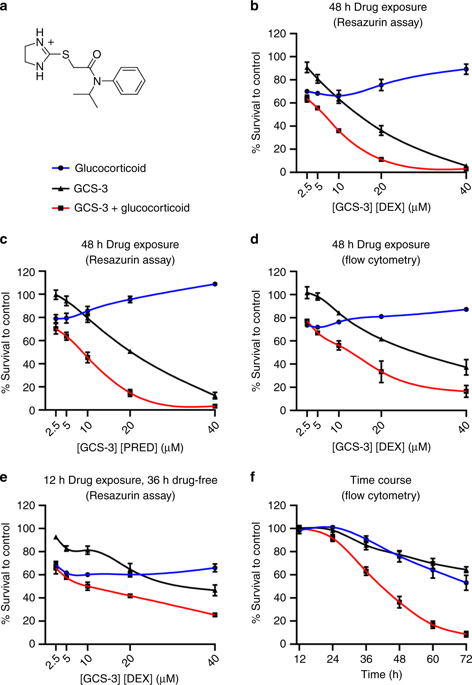British Journal of Cancer ( IF 6.4 ) Pub Date : 2020-04-03 , DOI: 10.1038/s41416-020-0824-8 Cara E Toscan 1 , Duohui Jing 1 , Chelsea Mayoh 1 , Richard B Lock 1

|
Background
Acute lymphoblastic leukaemia (ALL) is the most common paediatric malignancy. Glucocorticoids form a critical component of chemotherapy regimens and resistance to glucocorticoid therapy is predictive of poor outcome. We have previously shown that glucocorticoid resistance is associated with upregulation of the oncogene C-MYC and failure to induce the proapoptotic gene BIM.
Methods
A high-throughput screening (HTS) campaign was carried out to identify glucocorticoid sensitisers against an ALL xenograft derived from a glucocorticoid-resistant paediatric patient. Gene expression analysis was carried out using Illumina microarrays. Efficacy, messenger RNA and protein analysis were carried out by Resazurin assay, reverse transcription-PCR and immunoblotting, respectively.
Results
A novel glucocorticoid sensitiser, 2-((4,5-dihydro-1H-imidazol-2-yl)thio)-N-isopropyl-N-phenylacetamide (GCS-3), was identified from the HTS campaign. The sensitising effect was specific to glucocorticoids and synergy was observed in a range of dexamethasone-resistant and dexamethasone-sensitive xenografts representative of B-ALL, T-ALL and Philadelphia chromosome-positive ALL. GCS-3 in combination with dexamethasone downregulated C-MYC and significantly upregulated BIM expression in a glucocorticoid-resistant ALL xenograft. The GCS-3/dexamethasone combination significantly increased binding of the glucocorticoid receptor to a novel BIM enhancer, which is associated with glucocorticoid sensitivity.
Conclusions
This study describes the potential of the novel glucocorticoid sensitiser, GCS-3, as a biological tool to interrogate glucocorticoid action and resistance.
中文翻译:

儿童急性淋巴细胞白血病糖皮质激素耐药性的逆转依赖于 BIM 表达的恢复。
背景
急性淋巴细胞白血病(ALL)是最常见的儿科恶性肿瘤。糖皮质激素是化疗方案的重要组成部分,对糖皮质激素治疗的抵抗预示着不良结果。我们之前已经表明,糖皮质激素抵抗与癌基因C-MYC的上调和促凋亡基因BIM的诱导失败有关。
方法
开展了一项高通量筛选 (HTS) 活动,以确定针对源自糖皮质激素耐药儿科患者的 ALL 异种移植物的糖皮质激素敏化剂。使用 Illumina 微阵列进行基因表达分析。分别通过刃天青测定、逆转录PCR和免疫印迹进行功效、信使RNA和蛋白质分析。
结果
HTS 活动中鉴定出一种新型糖皮质激素敏化剂 2-((4,5-二氢-1 H-咪唑-2-基)硫基) -N-异丙基-N-苯基乙酰胺 (GCS-3)。敏化作用是糖皮质激素特有的,并且在一系列地塞米松耐药和地塞米松敏感异种移植物(代表 B-ALL、T-ALL 和费城染色体阳性 ALL)中观察到协同作用。 GCS-3 与地塞米松联合下调糖皮质激素耐药 ALL 异种移植物中的C-MYC并显着上调BIM表达。 GCS-3/地塞米松组合显着增加了糖皮质激素受体与新型BIM增强剂的结合,这与糖皮质激素敏感性相关。
结论
这项研究描述了新型糖皮质激素敏化剂 GCS-3 作为检测糖皮质激素作用和耐药性的生物工具的潜力。











































 京公网安备 11010802027423号
京公网安备 11010802027423号